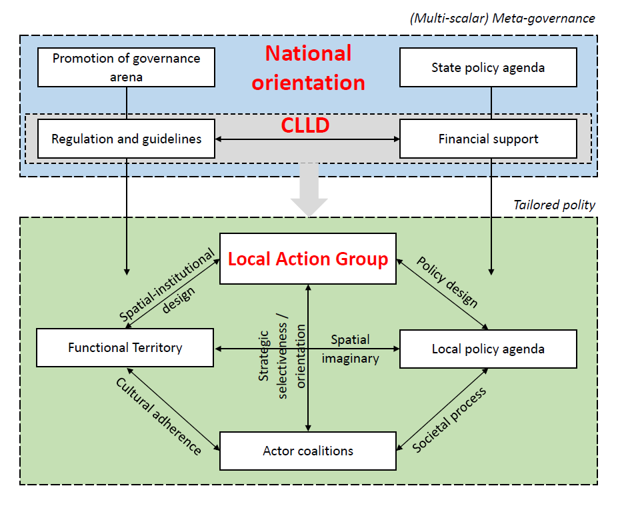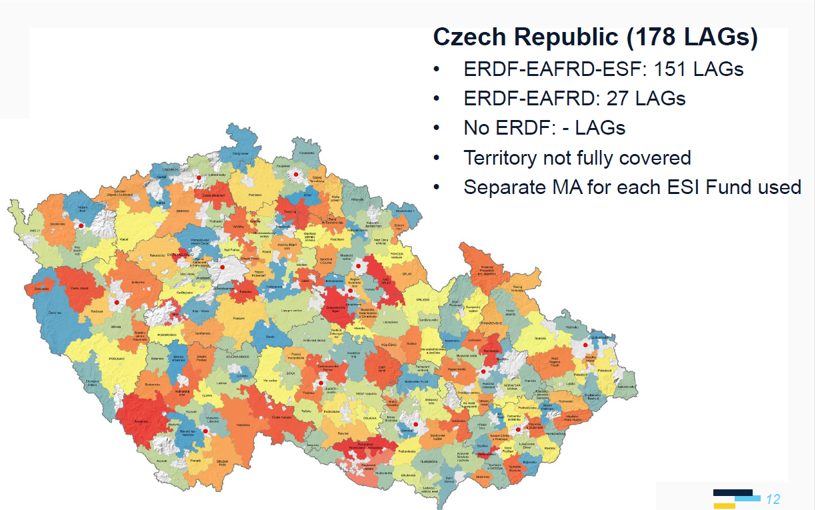The Community-Led Local Development (CLLD) instrument is one of the most interesting “territorial delivery mechanisms” of the current EU 2014-2020 programming period. Built on the former LEADER project, it attempts to overcome the sectorial (rural or maritime) approach of the previous instrument through a more integrated local-development policy agenda for ad-hoc sub-regional and urban areas. Despite some administrative complexities, this instrument has offered the ground for interesting governance experimentations that are worth investigating from a theoretical and empirical perspective. Among the various dimensions, it is interesting for the tailoring of a specific area (from urban neighbourhood to cross-border regions), for the explicit bottom-up dynamic and community engagement (as mentioned in its acronym), and for the setting and the implementation of an integrated and strategic plan fostering local development.
These were the ideas behind the launch of a special session in the annual Regional Studies Association conference, which was dedicated to the theme “Pushing Regions Behind Their Borders” and that took place in Santiago de Compostela (Spain) on the 5th June – 7th June 2019. The special session was titled “Community-Led Local Development (CLLD): experimental governance and task-specific space for policy action”.
The call for contribution to the special session underlined that the tailoring of the task-specific regional constituency for policy action is a key concern for regional studies, as well as for political science and local and regional planning. Together with the investigation of the policy for which the tailored region is conceived, a broad variety of studies have underlined the importance of other dimensions, such as:
- the relationship between spatiality (functional dimension) and territoriality (the delimitated space of policy action);
- the role of spatial imaginaries as catalyst of policy action and political coalitions;
- the multi-level governance architecture, the meta-governance framing, and the vertical and horizontal shift of competences and power;
- the specificity of the Local Action Group as new policy arena, and its institutional design;
- the community’s role in the process, and the legitimacy of the regional constituency.
Accordingly, the session was interested to gather studies, cases and approaches to the CLLD that follow these lines of investigations. It aimed at sharing knowledge and experiences that could include, but were not limited to, the following four sub-themes:
- The spatiality of the generated region. What is the cultural adherence between the tailored space and the societal dynamics? What is the relationship with the territoriality of the local administrations and what type of territorial synchrony is foreseen? To what extent it has the potentiality to become a new polity for further policy actions?
- The spatial imaginary and the policy agenda. What spatial dimensions have been addressed? What is the novelty in terms of spatial imaginary associated to small and medium sized towns and in-between territories, urban-rural integration, and/or urban areas? Contextually, how EU funds’ characteristics are supporting or limiting the constituency of new spatial narrative?
- The role of multilevel governance process and the state’s role. How has the institutional design shaped the policy agenda and the spatial polity? How did the multi-scalar decision making set the institutional boundary of the CLLD implementation (through eligible funds, areas, and/or actors) in specific countries or regions?
- The democratic experimentalism and new forms of deliberation. What is the role of the Local Action Group and its societal composition? Are there innovative forms of participation and decision-making processes? What forms of public and private interactions were set up?
The call for participation received 6 contributions, which were articulated in 2 well-attended sections. The line-up, with authors and title of their presentation is presented here below.
Section 1- Trends in CLLD Implementation
a. Loris Servillo (UCL, UK; Politecnico di Torino, IT)– Tailored Polities and Bottom-up Dynamics in the Shadow of the State’s Hierarchy: The CLLD Implementation and a Future Research Agenda.
This presentation framed the entire special session, discussed the several theoretical implications for the investigation of the CLLD and gave an overview of the implementation of the more than 3000 LAGs across the EU.
From Loris Servillo’s PPT presentation (Original document: Servillo, 2019, see references):
b. Stefan Kah (University of Strathclyde, UK) – Implementing ERDF through CLLD: Experiences so far.
Building on the previous presentation, a more in-depth overview of the LAG characteristics was presented, zooming-in in few countries, such as Sweden, Slovenia, and Czech Republic.
From Stephan Kah’s PPT presentation:

c. Dávid Fekete (Szechenyi Istvan University, Hungary) – The Role of CLLD-projects in the Governance of Hungarian Big Cities.
This presentation provided an overview of the urban application of the CLLD, in particular in the Hungarian context, which is characterised only by urban-CLLD, and a zoom-in of a specific case.
Section 2 – Community-led Experiences and Issues
a. Kim Pollermann (Thünen Institute of Rural Studies, Germany) – Participation in Rural Development – The View of Non-participants.
This presentation addressed an interesting and original dimension: the perception of the local development initiative from the non-participants’ perspective. It presented some early findings of an ongoing research in some German rural areas interested by CLLD initiatives.
b. Urszula Budzich-Tabor – (FARNET SU) – Community-led Local Development: some lessons from fisheries areas.
An insightful overview on the operative implementation of CLLD gave specific details of administrative virtues and struggles in LAG areas, coming from a direct reporting of the fisheries LAGs across the EU.
c. Judith Hann (Cornwall Development Company, UK) –The Implementation of Community Led Local Development in a Less Developed Region of the UK: A Cornwall Case Study
 The Cornwall case exposition provided a very detailed and brilliant exposition of the cultural dynamics that generated the strategy, of the added values of the integrated approach, of the administrative constraints that a multi-fund CLLD could face at the local level, and of the role that the upper levels retains in supporting or hampering the process.
The Cornwall case exposition provided a very detailed and brilliant exposition of the cultural dynamics that generated the strategy, of the added values of the integrated approach, of the administrative constraints that a multi-fund CLLD could face at the local level, and of the role that the upper levels retains in supporting or hampering the process.
Additionally, we clustered the special session at the RSA conference dedicated to the role of research in policy making: Strengthening the Impact of Research on EU Local Development Policies.
The various presentations and the vivid discussions that took place in both sessions provided a series of interesting insights. Few conclusions can be drawn from the two debates.
- The uniqueness of the CLLD lays in its added values: it enables a genuine bottom-up approach, a broader range of eligible themes in an integrated fashion, and allows the targeting of a variety of territories, from urban neighbourhood to functional areas with small and medium sized towns.
- The CLLD instrument has been quoted as ‘broker of small projects’, whose effectiveness can only be achieved through the critical mass reached through a local development strategy. The activation of these micro projects, which are vital for local communities and entrepreneurs, is hard to be achieved though the traditional financing channels, while the CLLD offers an operative umbrella that guarantees synergy and a strategic added value.
- On the one hand, CLLD fosters increased synergies between different policy areas, with possible ways to simplify the procedures (for beneficiaries), e.g. using a one-stop-shop approach; on the other hand it is still perceived – and implemented– as a very complicated and burdensome administrative instrument.
- Despite its local dimension and the operative emphasis at the local level, the higher levels and the entire vertical-governance chain of decision-making is crucial for an effective implementation of the instrument. It has implication in both the capacity to address locally the right territory with the adequate financial means, and the administrative capacity to implement the projects.
- The next programming period represents a key political challenge. The partial positive take-up of the new opportunity of the CLLD in the current programming period (integration of funds and larger variety of territories) can be seen as promising, imagining a wider widespread of the CLLD approach in a larger number of countries. At the same time, cultural and administrative struggles need to be overtaken.
- The silos mentalities and the lack of administrative cultural attitude in pursuing integration (of funds, and of territories), the ability to activate unusual and creative cooperation among actors, plus the struggles among sectors in charge of their ‘own’ budget / fund, remain the main critical / cultural dimensions.
- The characteristics of the CLLD regulation in the next programming period, as they appear in the draft documents, seem to have solved some of the criticalities (e.g. through simplified procedures), but also have made some of the specific features more blurred, such as the threshold of inhabitants and the composition of the LAG. In this sense, it is vital to capitalise on the experiences of the current programming period and to launch a massive campaign to foster a genuine integrated territorial approach, relying on the existing good practices.
References
Servillo L. (2019) Tailored polities in the shadow of the state’s hierarchy. The CLLD implementation and a future research agenda, European Planning Studies, 27(4), 678-698.
https://www.tandfonline.com/doi/full/10.1080/09654313.2019.1569595
[free access]
Servillo, L., De Bruijn, M. (2018). From LEADER to CLLD: The Adoption of the New Fund Opportunities and of Their Local Development Options. European Structural and Investment Funds Journal, 6(3), 223–233.
https://estif.lexxion.eu/article/ESTIF/2018/3/5
[free access]
Leave a Reply
You must be logged in to post a comment.